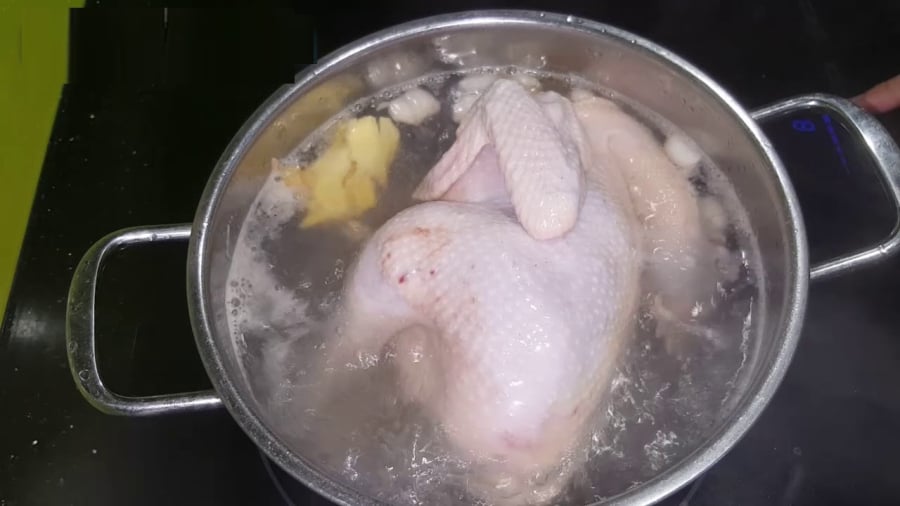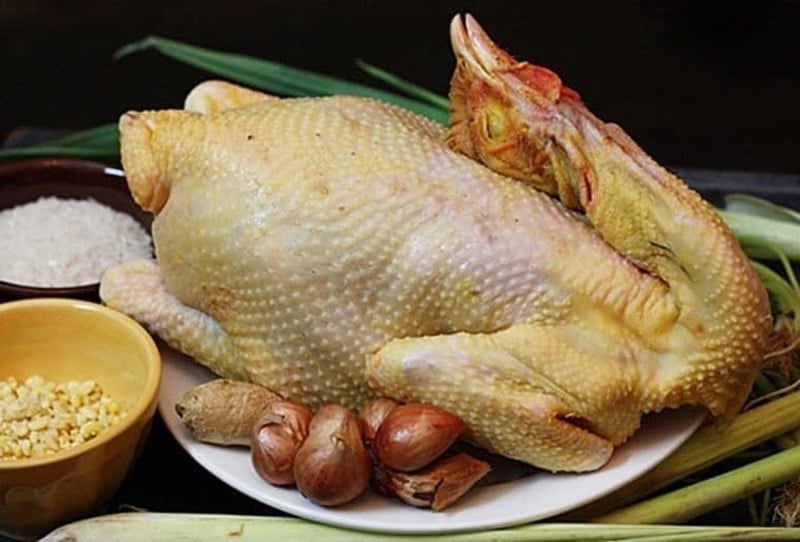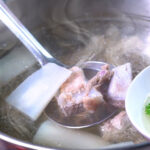There are a few simple steps you can follow to achieve the perfect boiled chicken:
Select fresh chicken and clean it thoroughly: Choose a fresh chicken, rinse it, and rub salt and vinegar on its skin to eliminate any unpleasant odors.
Brine the chicken before boiling for enhanced flavor and even cooking: Soak the chicken in a diluted brine solution for 15-20 minutes. This helps the meat retain moisture and reduces the presence of blood in the bones.

Soaking the chicken in diluted brine for 15-20 minutes helps the meat tighten and reduces blood in the bones.
Start boiling in cold water: Prepare a pot of cold water large enough to submerge the chicken. Add two bulbs of onion, a tablespoon of salt, two tablespoons of seasoning, a splash of cooking wine or fish sauce, and a small piece of ginger (note: if you plan to use the broth for another dish, go easy on the ginger as too much can overwhelm the flavor).
By starting with cold water instead of boiling water, you ensure a gradual increase in temperature, allowing the chicken to cook evenly from the inside out without causing the bones to turn red.

Boiling chicken in cold water prevents bone discoloration and meat from becoming sticky: This extra step ensures even cooking and enhances flavor.
Maintain a gentle simmer and avoid vigorous boiling: Once the water starts to gently bubble, reduce the heat to maintain a gentle simmer. Cooking the chicken at a moderate temperature helps it cook slowly, retain its color, and prevents bone discoloration and skin tearing.
Boiling time and resting the chicken: The boiling time depends on the size of the chicken. For a chicken under 2kg, boil for 3-5 minutes. For a chicken over 3.5kg, boil for 10 minutes. Then, turn off the heat and let the chicken rest in the broth for 30 minutes. This ensures that the bones don’t turn red, and the meat remains juicy and tender.
Checking for doneness: Use a skewer to pierce the thigh; if the juices run clear, the chicken is cooked.

Rinse the cooked chicken with cooled boiled water or ice-cold water for an even crispier and shinier skin.
To select the freshest and safest chicken for your dish, consider the following tips:
Choosing a live chicken
Bright eyes: A healthy chicken typically has bright and lively eyes. If the eyes appear cloudy or dull, the chicken may be sick.
Smooth feathers: A chicken with smooth and sleek feathers is usually a sign of good health.
Slim legs: Opt for chickens with slim, yellow-colored legs. Avoid chickens with pale or black-spotted legs.
Firm body: Gently squeeze the chicken’s breast area. If it feels firm, the meat is likely to be tasty and tender.
Choosing a pre-slaughtered chicken
Skin: A delicious chicken will have naturally yellow skin, especially in the breast, wing, and back areas. The skin should be thin and elastic, without any bruises or blood clots.
Firm meat, no sogginess: Fresh chicken meat is usually firm, taut, and bouncy. If you press it and it returns to its original shape without any indentation, it’s a good sign.
Natural aroma: Fresh chicken has a subtle, distinctive scent. If it smells strange, pungent, or foul, it’s best to avoid it as it may no longer be fresh.
No water injection: Water-injected chickens often have abnormally swollen meat, especially in the breast and thigh areas. If the meat feels soft and mushy to the touch, it’s best to choose another bird.
Choosing frozen chicken
Reputable source: Opt for well-known brands with clear expiration dates. Ensure the chicken has been stored at the appropriate temperature.
Intact packaging, minimal frost: Good-quality frozen chicken will have intact packaging with minimal frost buildup. If there’s significant frost or ice buildup, it may indicate that the chicken has been thawed and refrozen, compromising its quality.
The Secret to Making Finger-Lickin’ Good Fried Chicken at Home
With this mouth-watering fried chicken recipe, you can enjoy restaurant-quality food at home without breaking the bank. The secret lies in the marinade, a blend of carefully selected spices and herbs that infuse the chicken with flavor. It’s a simple yet effective method that will revolutionize your home cooking and impress your taste buds.
The Ultimate Bone Broth Recipe: A Simple Guide to Tender Meat and a Clear, Sweet Broth
“When it comes to bone broth, there’s a secret to achieving that perfect, mouthwatering flavor and tender meat. The key lies in the addition of a few simple ingredients that will transform your broth and take your culinary skills to the next level. Uncover the magic behind creating a delicious bone broth that will have your guests asking for more.”



































